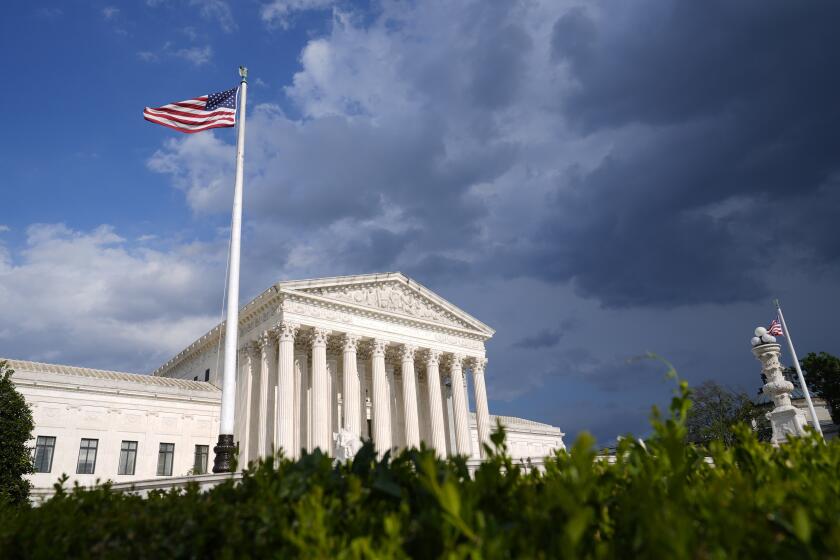Peacefully, the disabled and the dead from...
Peacefully, the disabled and the dead from the nation’s wars coexist on a 19th-Century military outpost by a 20th-Century freeway next to UCLA.
Shortly before the turn of the century, when health retreats were springing up all over Southern California, a federally funded version, the Pacific branch of the National Home for Disabled Volunteer Soldiers (now the Veterans Administration Center), opened its doors in the 600-acre expanse of treeless slopes and bush-grown gulches.
The site, at what is now Wilshire Boulevard and the San Diego Freeway, was chosen by the government for its “climate and hygiene” from more than 60 offers of free land, including all of Santa Catalina Island. Almost every community in Southern California was vying for the $250,000 annual federal budget and more than $66,000 in pensions that would come to their neighborhoods with the facility.
*
The winners in the land giveaway were Nevada Sen. John Percival Jones, a silver magnate, and his partner, former Rhode Islander Robert S. Baker. Their offer was at the bottom of the government’s list, but the 300 free acres were sweetened by a gift of $50,000. (The other 300 acres were donated by a ranch and a local water company.)
In return for their generosity, the two land barons hoped that the presence of the facility would generate local jobs, attract business--and prompt people to buy land in a new town they owned, Santa Monica.
The renowned architect Stanford White designed the facility, but some soldiers couldn’t wait for construction to begin. On May 2, 1888, a Civil War veteran, Pvt. George Davis of New York, not willing to put up with another New York winter, became the first veteran to arrive at the home, taking up residence in a tent set up on the grounds. Veterans did not have to be sick or wounded to live in the free facility.
*
Within a year, a thousand eager veterans would follow Davis into the newly built institution, including 100 elderly men from Northern California who marched 500 miles for free lodgings.
Over the years, the government would add a library, theater, dining hall, chapel, post office, laundry, hospital and more barracks, room for 2,000 veterans. Rich soil and mild weather made the land surrounding the horseshoe-shaped retreat ideal for planting fruit orchards and lima bean and barley fields to feed the pensioners and to be sold.
On the grounds of the home in 1901, thousands of Angelenos hailed President William B. McKinley as he addressed Civil War and Spanish-American War veterans. Three years earlier, many had answered the President’s call for volunteers in the conflict with Spain, and now, spruced up in their best uniforms, they saluted him.
McKinley told them: “The government for which you fought, to which you gave the best years of your lives . . . that government will see to it that in your declining years you shall not suffer”--here the crowd applauded--”but shall be surrounded with all the comforts and all the blessings which a grateful nation can provide.”
Four months after McKinley’s visit, he was assassinated.
*
Around the facility that White had designed, houses, duplexes and businesses were beginning to spring up to accommodate the growing Westside population, some of whom worked at the home. The community became known as Sawtelle, after the local banker, W. E. Sawtelle. So wide an influence did the home have that some of Sawtelle’s streets were named after Civil War battles, such as Vicksburg and Gettysburg--now Stoner and Colby avenues.
While the federal government attended to the needs of the veterans, a group called the Ladies of the Grand Army of the Republic looked after the veterans’ widows. Along Nevada Avenue--now Wilshire Boulevard--the auxiliary group built cottages for the women to live in rent-free, and by 1917, the street became known as Widows’ Row. (Some residents of Widows’ Row moved in with the intention of getting married to the bachelor veterans nearby. A newspaper at the time said “a widow need not remain a widow longer than two weeks in Sawtelle.”)
In 1927, the James Wadsworth Hospital opened on the grounds of the home, named after a Civil War major and--not coincidentally--former president of the board of the National Homes for Disabled Veterans.
In 1971, the Sylmar earthquake would lead to the condemnation of the Wadsworth hospital. A more modern facility was built in its place, and it was there that a festering epidemic of Legionnaire’s disease claimed 46 lives between 1977 and 1981.
The hospital and barracks housed more than 4,500 veterans by the early 1960s, and another 2,000 in its Brentwood Psychiatric Hospital.
But by the late 1960s, Stanford White’s designs had become quaint fire hazards. And so the last of the older buildings--unique and whimsical wood structures, with gingerbread trim and wide verandas where some of the rocking-chair brigade had sat from dawn to sunset--were condemned to the wrecking ball.
It spared only the newer buildings and three of the earliest: the chapel, the hospital governor’s mansion and a Civil War-era house.
Now, where thousands of war veterans once spent their last years, there stands the Veterans’ Administration Center, the largest military hospital in the nation.
More to Read
Sign up for Essential California
The most important California stories and recommendations in your inbox every morning.
You may occasionally receive promotional content from the Los Angeles Times.










